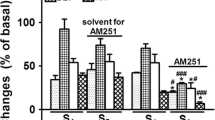Abstract.
In anaesthetized rats activation of vanilloid receptors on sensory vagal nerves elicits rapid bradycardia and hypotension (Bezold-Jarisch reflex). Recent in vitro experiments revealed that the endogenous cannabinoid ligand anandamide acts as an agonist at the vanilloid VR1 receptors. The present study was aimed at examining whether vanilloid VR1 receptors are involved in the cardiovascular effects of anandamide in the anaesthetized rat.
Intravenous injection of anandamide, its stable analogue methanandamide and the vanilloid receptor agonist capsaicin produced a dose-dependent immediate and short-lasting decrease in heart rate and blood pressure with the following rank order of potencies: capsaicin > methanandamide > anandamide. This bradycardia was dose-dependently diminished by the selective vanilloid receptor antagonist capsazepine (0.3–3 µmol/kg) and the nonselective inhibitor of these receptors, ruthenium red (1–10 µmol/kg). Both antagonists reduced or tended to reduce the hypotension stimulated by the agonists. Following this bradycardia and hypotension (presumably evoked by the Bezold-Jarisch reflex; phase I), capsaicin, anandamide and methanandamide led to a brief vasopressor effect (phase II). Subsequently both anandamides, but not capsaicin, induced a more prolonged decrease in blood pressure (phase III). Capsazepine and ruthenium red (at doses up to 3 µmol/kg and 10 µmol/kg, respectively) failed to affect these changes in blood pressure. The cannabinoid CB1 receptor antagonist SR 141716 at 3 µmol/kg abolished the prolonged decrease in blood pressure (phase III) induced by anandamide and methanandamide, but had no effect on the reflex bradycardia and hypotension (phase I) and on the subsequent vasopressor effect (phase II) evoked by capsaicin, anandamide and methanandamide.
In conclusion, the endogenous cannabinoid receptor agonist anandamide and its stable analogue methanandamide induce reflex bradycardia and hypotension (phase I) by activating the vanilloid VR1 receptor. Whereas the mechanism underlying the brief vasopressor effect (phase II) is unknown, the prolonged hypotension (phase III) results from stimulation of the cannabinoid CB1 receptor.
Similar content being viewed by others
Author information
Authors and Affiliations
Additional information
Electronic Publication
Rights and permissions
About this article
Cite this article
Malinowska, B., Kwolek, G. & Göthert, M. Anandamide and methanandamide induce both vanilloid VR1- and cannabinoid CB1 receptor-mediated changes in heart rate and blood pressure in anaesthetized rats. Naunyn-Schmied Arch Pharmacol 364, 562–569 (2001). https://doi.org/10.1007/s00210-001-0498-6
Received:
Accepted:
Published:
Issue Date:
DOI: https://doi.org/10.1007/s00210-001-0498-6




